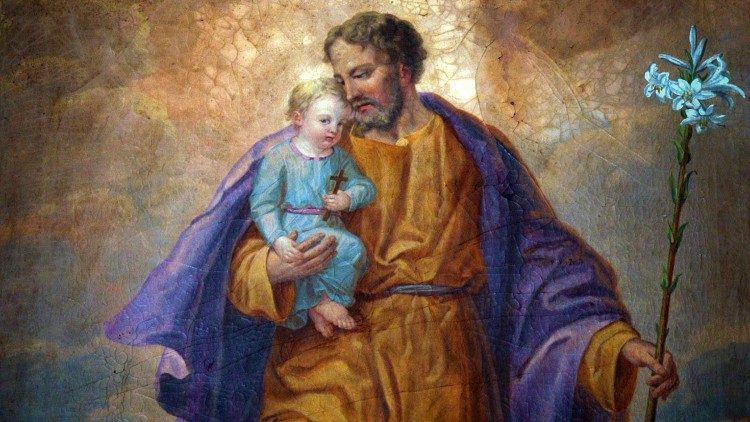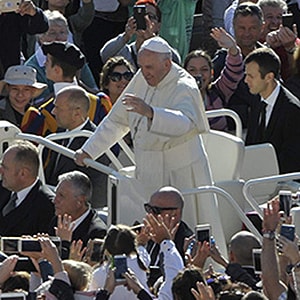
St Joseph: the man whom Heaven trusts
By Alessandro De Carolis
Every day for 40 years, Pope Francis has challenged St Joseph. After saying Morning Prayer, Pope Francis writes in Patris corde, he recites a nineteenth century prayer from a French prayerbook.
Through this prayer, the Pope entrusts both “serious and troubling situations” to St Joseph. The prayer ends thus: “Let it not be said that I invoked you in vain”.
We find out about this daily custom in a footnote in Patris corde, a text that brings the memory of the Church back to Pope Pius IX who, on the Feast of the Immaculate Conception in 1870, proclaimed St Joseph the Patron of the Universal Church.
A strong connection
The anecdote confirms and enriches Pope Francis’s predilection for the figure of Mary’s husband. His familiarity with the Saint already become known when he spoke in Manila about a habit he has of putting his concerns under a statue of the “sleeping Joseph” which he keeps in his study at Santa Marta.
Joseph is a man who goes “unnoticed”, who welcomes the mystery and puts himself at its service, never putting himself at the center, but who resolves things that are impossible. In Patris corde, the Pope describes many of St Joseph’s qualities as a true husband and father, the fiancé who “accepted Mary unconditionally” and the man in whom “Jesus saw the tender love of God”.
Papal names
Pope Francis’s contribution is, so to speak, the last piece of the mosaic the Church has created throughout the centuries to express its admiration and to explain the merits of this great soul sculpted through silence.
Various Popes have also contributed to this narrative with heartfelt words and gestures. Beginning in the 15th century, Pope Sixtus V fixed 19 March as the date on which his feast is celebrated. From Pius IX on, and especially during the pontificates of the 20th century, the Church’s magisterium cast new light on this man wrapped in shadow.
His name, however, has never been chosen by a Pope, even if in the last decades, his name has recurred frequently in the baptismal names of various popes: Popes Pius X (Giuseppe Melchiorre Sarto), John XXIII (Angelo Giuseppe Roncalli), John Paul II (Karol Józef Wojtyla), Benedict XVI (Joseph Ratzinger). Pope Francis is not named Joseph, but he initiated his ministry by celebrating Mass on 19 March: a different connection but the same proximity.
Adding a name
Confirming Pope Benedict XVI’s desire, Pope Francis decreed on 1 May 2013 that the name of St Joseph, the Spouse of the Blessed Virgin Mary, be added in Eucharistic Prayers II, III and IV. Before that, on 13 November 1962, Pope John XXIII had established that his name be inserted into the Roman Canon, alongside Mary’s name and before those of the Apostles.
Pope John XXIII himself, wishing to entrust the Second Vatican Council to Jesus’s earthly “daddy”, wrote the Apostolic Letter Le Voci in 1961. In it, he included a sort of summary of devotion to St Joseph nurtured by his predecessors. These are not merely ambiguous aspects of liturgical “bureaucracy”. Each new decree demonstrates an ever more deeply rooted ecclesial sense and awareness, which with Pius XII even touched civil life.
The workers’ saint
1 May 1955. It was a Sunday and a crowd of workers filled St Peter’s Square. They were members of ACLI (Italian Association of Christians Workers), and many of them remembered their meeting with Pius XII ten years before on 13 March 1945, a month and a half before the end of the war that had profoundly wounded Italy. Now the country was experiencing immense growth, the “boom” was not far off.
But among the ranks of Italian Catholics, the Pope recognized those who were “disheartened”, those who complained about the lack of a Christian presence “in public life”, while socialist ideologies seemed to be taking over. Pius XII’s energetically recalled ACLI to their original identity so that they might be committed to “social peace”. In the end, completely shifting gears, he gave them a “gift” which surprised and enthused those present:
We are pleased to announce to you Our determination to establish -- and we in fact establish -- the liturgical feast of St Joseph the Worker, assigning to it the precise date of 1 May. Dear workers, are you happy about Our gift? We are certain that you are because the humble artisan of Nazareth not only personifies the dignity of the worker before God and the Holy Church, but he is also always the provident guardian of you and your families.
There can never be a “Pope Joseph”
Four years later, the Church was guided by a man who would have wanted to choose the name “Pope Joseph”. He decided against it, however, saying that it was not a name used by the popes.
But his explanation betrays a nostalgia and reveals Pope John XXIII’s strong attachment to St Joseph. The revelation came during an audience on 19 March 1959 with a group of street cleaners. In a radio message on 1 May the following year, “Good Pope John” concluded with a prayer to St Joseph the Worker:
Grant that those you protect understand that they are not alone in their work, but may they know how to find Jesus next to them, may they welcome Him with grace, and faithfully protect Him as you did. Grant that in every family, in every office, in every laboratory, wherever a Christian works, that they may all be sanctified in charity, in patience, in justice, trying to doing things well, so that the gifts of heavenly predilection might abundantly descend upon them.
A risk-taker
Even though Pope Paul VI’s name was not Joseph, from 1963 to 1969 in particular, a year did not go by in which he did not celebrate Mass on the Solemnity of 19 March. Every homily he delivered on that occasion was a personal “portrait” of how fascinated he was by St Joseph’s “complete submission and dedication” to his mission, of the man who was “timid perhaps”, but gifted “by a superhuman greatness that enchants”. Even though having a bride like Mary and a Son like Jesus made him a stranger among his peers, he did not retreat. About this, Paul VI said in 1969:
St Joseph was, therefore, a man who was ‘committed’, as they say now, to Mary, chosen from among all the women on earth and all of history, always his virgin bride, not physically his wife, and to Jesus, by virtue of legal, not natural, descendance, his offspring. His were the burdens, the responsibilities, the risks, the little preoccupations of the small and singular holy family. His were the service, the work, the sacrifice, the penumbra of the evangelical scene in which we like to contemplate him. And certainly, not wrongly so, now that we know everything, we call him happy, blessed. This is the Gospel. In it, the values of human existence assume a different value than that which we are accustomed to appreciate: here that which is small becomes great.
The sublime spouse
In the 26 years of Pope John Paul’s pontificate, there were an infinite number of occasions on which he spoke of St Joseph to whom he said he prayed intensely every day. He summarized this devotion in the Apostolic Exhortation Redemptoris Custos, published on 15 August 1989, written 100 years after Pope Leo XIII’s Encyclical Quamquam Pluries. In that document, Pope John Paul explores every aspect of St Joseph’s life. Sensitive as he was to the vocation of Christian marriage, he offered it as a way of profoundly interpreting the relationship between the couple from Nazareth – “the grace of living together the charism of virginity and the gift of matrimony” – a theme he would pick up in a general audience in 1996, deconstructing a false myth:
The difficulty of approaching the sublime mystery of their spousal communion has led some, since the second century, to attribute an advanced age to Joseph and to consider him as a guardian, instead of as Mary’s husband. Rather, it is appropriate to suppose that he was not an elderly man, but that his interior perfection, a consequence of grace, led him to live his spousal relationship with Mary with virginal affection.
“Robust interiority”
There are no words left by the man for whom Matthew in his Gospel uses the term “just”, the Patron of the Universal Church, of workers and of an infinite number of cities, churches and places. All we have is silence.
His actions, therefore, must be understood as if they were words and thoughts. From that apparent absence, even Pope Benedict XVI extracted the wealth of a complete life, of a man in the background, whose silent example affects the growth of Jesus, the God-man:
It is a silence thanks to which Joseph, in unison with Mary, watches over the Word of God. (…) A silence woven of constant prayer, a prayer of blessing of the Lord, of the adoration of his holy will and of unreserved entrustment to his providence. It is no exaggeration to think that it was precisely from his ‘father’ Joseph that Jesus learned - at the human level - that steadfast interiority which is a presupposition of authentic justice, the "superior justice" which he was one day to teach his disciples.
Thank you for reading our article. You can keep up-to-date by subscribing to our daily newsletter. Just click here








